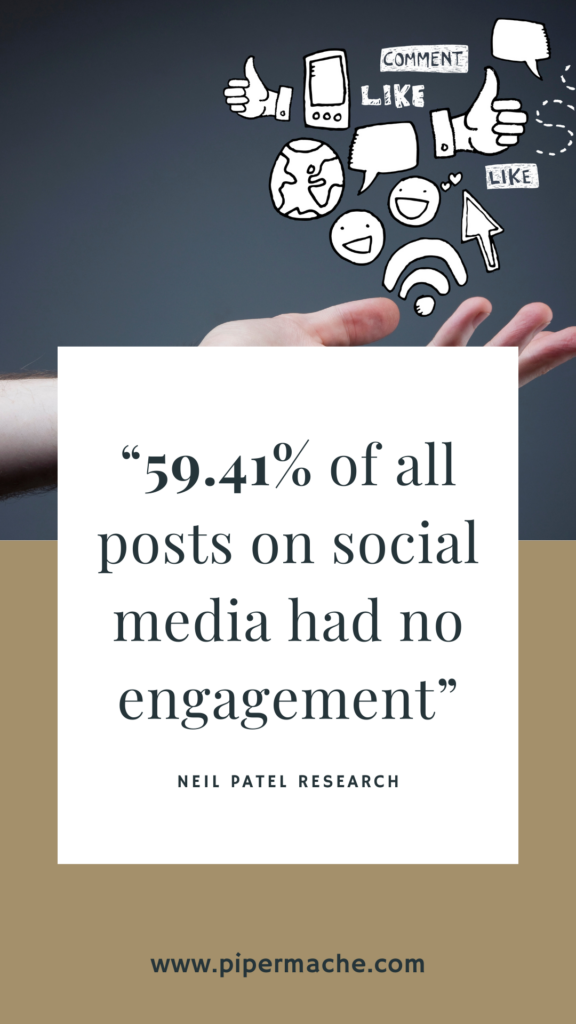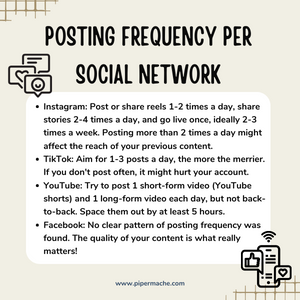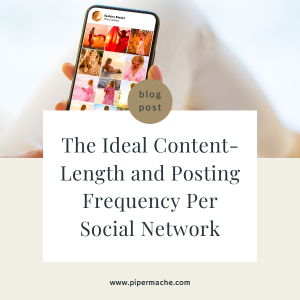Have you ever wondered what is the ideal content-length and what is the correct posting frequency for your social media accounts? It can sure feel like we are posting into the a black hole sometimes. Social Media is somebody else’s turf, but we depend on that to create and nurture out community and market our websites. Some posts are a hit, some just go by unseen. If you are posting on social media without direction, I invite you to look at the data from a study done by Neil Patel and his team.
There are over 1.1 billion pieces of content being published a day on social media. So social networks don’t lack content, however, Neil Patel’s team found that 59.41% of all posts had no engagement. Haven’t you experienced that before too? The silence and lack of engagement after you worked hard to share one of your products, or excitement over your new services?

In order to make this study manageable Neil Patel’s team analyzed 5,204,391 social media posts over a 30-day period. I am going to share a few of the results with based on the social media platforms that my clients use the most to promote their website and content.
The Ideal Content-Length Per Social Network according to Neil Patel’s study
Let’s start with;
1- Instagram Ideal Content-Length
Guess what Neil Patel’s team found out? When it comes to publishing reels, if you’re aiming to entertain, your sweet spot is videos that are between 11 to 17 seconds long.
And if you’re in the mood to educate? Your audience loves videos that run for about 38 to 51 seconds.
When it comes to carousels, aim for 7 to 10 slides. Here’s a little secret: make sure you have a hook on both the first and second slide. Trust me, just having a hook on the first slide won’t cut it for high engagement.
2- TikTok Ideal Content-Length
Hey there, fearless video creator! You’re probably a big fan of TikTok, aren’t you? When you’re crafting those fun, entertaining videos, aim for a sweet spot between 18 and 31 seconds to get the most engagement.
And for the times when you’re in the mood to share some knowledge? Your educational content is a hit when it’s between 42 to 54 seconds long. Keep up the great work!
3- YouTube Ideal Content-Length
I must admit, YouTube is an adventure I’m still exploring. I’ve dipped my toes in the water with a few video posts. Now, let’s see what advice Neil Patel’s team has for us. When it comes to Shorts, aim for a snappy 28 to 33 seconds if you’re going for laughs. But if you’re sharing some wisdom, a duration of 41 to 57 seconds is your sweet spot.
As for long-form videos, they shine when they’re around 7 minutes and 9 seconds long. So go ahead, take your time and let your creativity flow!
4- Facebook Ideal Content-Length
I might be showing my age a bit here, but I have a soft spot for Facebook – it’s my social media platform of choice! I guess I just love staying connected with everyone on there.
Facebook was instrumental in helping me establish a successful online business in the past, although I’m well aware that it’s a whole new ballgame now.
Even the clever folks over at Neil Patel’s team found themselves scratching their heads when it came to Facebook. They attempted to identify patterns on Facebook, but didn’t really get anywhere.
They suggested that maybe, just maybe, there might be some patterns lurking if they were to scrutinize a much larger set of content… say, 10 or 20 million posts. But as it stands, no discernible patterns were found on Facebook.
Whether the content was brief or lengthy, it didn’t seem to have any impact on engagement levels.
In fact, it’s worth noting that Facebook generally had the lowest engagement levels. It turned out to be one of the least successful platforms in terms of organic reach.
Posting frequency Per Social Network according to Neil Patel’s study
Just a quick heads-up on optimal posting frequency for different social media platforms, based on Neil Patel’s team study of 332,490 accounts:
- Instagram: Post or share reels 1-2 times a day, share stories 2-4 times a day, and go live once, ideally 2-3 times a week. Posting more than 2 times a day might affect the reach of your previous content.
- TikTok: Aim for 1-3 posts a day, the more the merrier. If you don’t post often, it might hurt your account.
- YouTube: Try to post 1 short-form video (YouTube shorts) and 1 long-form video each day, but not back-to-back. Space them out by at least 5 hours.
- Facebook: No clear pattern of posting frequency was found. The quality of your content is what really matters!

A case-study supporting email marketing
Wrapping up, Neil Patel encourages us to keep creating awesome content to delight our community. Good content will win anytime. But hey, let’s not forget about that trusty old friend – our email list. It’s like our secret weapon for our business.
My secret sauce: I’ve been implementing the evergreen content strategy. That means that I create content that I know will live online forever, evergreen. I create content mainly for my blog. I then share that content to my social networks and email.
(PS: You can sign up for my email here)
Sure, being present on social media is great, but, as you’ve seen from this study, it might not be worth investing loads of time or money into, especially if the returns aren’t that high. So, I believe we should pour our energy and resources into streamlining our business and fostering our community through good old-fashioned emails and evergreen content (aka blog).
Neil Patel himself gives a thumbs up to emails as one of the best ways to chat with your customers. Here’s a fun tidbit: A whopping 4 out of 5 marketers would choose to give up social media before they’d say goodbye to email marketing. Pretty cool, right?
How much time do you spend on social media weekly?

Be the first to comment